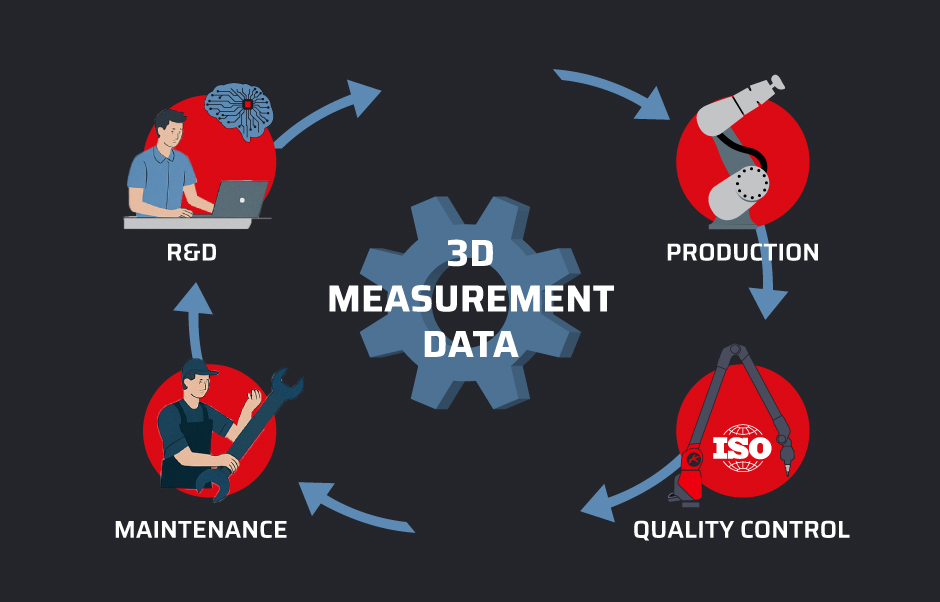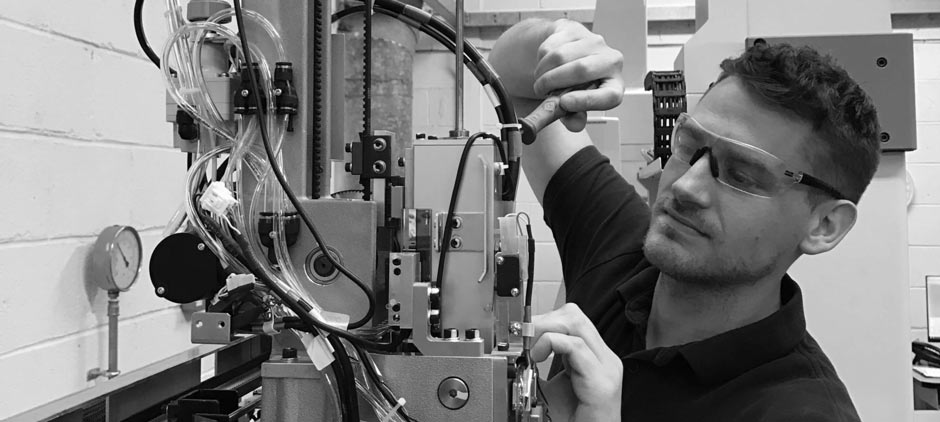with 3D scanners
In today’s manufacturing landscape, precision and efficiency are critical for the success of any product. From initial design concepts to the final stages of production, 3D acquisition and 3D measurement data play a vital role in optimising processes, ensuring quality and reducing errors.

3D acquisition data refers to the raw data captured during a 3D scanning process, such as point cloud data representing the entire surface geometry of an object without any interpretations.
The acquired data is typically unprocessed and used as the foundation for further analysis.
3D measurement data is the result of processing the acquisition data (mesh or point cloud), using metrology software. It can be used to extract geometric features, such as planes, cylinders, and circles.
Measuring tools, including measuring arms, scanners, and CMMs (Coordinate Measuring Machines), provide 3D acquisition data and 3D measurement data. They facilitate the entire product life cycle, from design to maintenance.
3D acquisition data provides valuable insights during the R&D process, enabling engineers and researchers to make informed decisions based on real-world data and ultimately contributing to higher-quality outcomes.
The R&D department utilises 3D metrology data for various development purposes.
In this phase, the initial ideas for a product are turned into detailed plans and then prototypes. It is crucial to have 3D data to ensure that the design will function as intended.
Before full-scale production, measurement data helps to validate prototype accuracy by comparing physical parts to design models. An analysis based on this data also offers R&D teams the opportunity to test new materials and concepts, thus promoting innovation and product performance optimisation.

Technical designers can use 3D scanners to capture accurate geometric details from physical prototypes, converting acquired data (point cloud) into meshes for further refinement. This enables faster prototyping and allows for easy modifications.
With 3D measured data, design engineers can enhance the manufacturing method of actual physical characteristics of parts and materials, eliminating guesswork, reducing the number of design iterations, and speeding up the development process.
For example, after initial prototype testing, a car manufacturer notices that drivers find the centre console’s armrest slightly uncomfortable during long trips. Instead of redesigning it from scratch, a technician reshapes the foam padding manually until it fits the ergonomic needs. The modified part is then 3D scanned, allowing designers to capture the exact geometry of the improved shape and integrate it directly into the CAD model, reducing iterations and accelerating the final design approval.
Once a First Article Inspection is completed on a part, the data can be used to create a 3D measurement range. From the early stages of manufacturing, the operator is guided through predefined control steps, thus optimising time and resources.
Kreon's range of Skyline 3D scanners is ideal for capturing detailed data from complex components. The 3D data can be integrated with CAD software for efficient design processes.

3D scanning solutions enable real-time inspection of parts during fabrication. This helps detect issues such as visible joint lines, deformations or shrinkage early in the process, allowing manufacturers to adjust quickly, reduce waste, and avoid defective products reaching the market.
By overlaying the measured point cloud or mesh onto the theoretical model, the software generates a color deviation map, visually highlighting variations. This analysis makes it easy to identify surface irregularities or tooling defects (alignment, wear, deterioration).
Advanced 3D inspection tools ensure each part aligns with tight design tolerances, detecting even minor variations. This is especially crucial in aerospace and automotive industries, where the smallest deviation can affect performance, safety, or assembly.
High-speed analysis of captured data with accuracy enables real-time statistical evaluation. By examining recurring deviations across multiple parts, it allows for maintaining long-term process stability and avoiding defect propagation.
3D metrology data not only validates the part but also supports tooling optimisation. Thanks to this data, manufacturers can refine tool geometry, adjust machine parameters to improve quality and minimise trial-and-error cycles in mold and die manufacturing, for example.

In the later stages of the product life cycle, maintenance and repair play a vital role in ensuring the continued functionality of the equipment.
By an inspection of the means to check their state of wear or their assembly quality, companies can predict when a part will likely fail and schedule maintenance before it leads to significant problems.
The flexibility of 3D measuring tools like measuring arms saves time by allowing inspections directly on the production line—no need to disassemble parts or move them to the metrology room.
For example, in the industrial machinery sector, 3D scanning can inspect large components such as turbines or engines. Technicians can rely on 3D data to detect defects and deterioration and thus decide whether the part should be repaired or replaced.
3D scanning technology allows manufacturers to recreate the legacy of distorted parts by capturing the exact dimensions of older or obsolete parts, creating digital models that can be used to reproduce them. This is particularly useful in industries where spare parts are no longer in production.
Without an existing CAD file, reverse engineering allows for adapting and improving existing designs.

3D scanning ensures that any new parts created through reverse engineering will fit perfectly with existing systems.This takes an environment to create a design in a complex assembly to draw at the right size and shape to fit.
3D scanning for reverse engineering offers numerous benefits:
3D measurement data is a foundation that supports every phase of the product life cycle in manufacturing. From the initial design and prototyping stages to mid-production.
Kreon Technologies offers cutting-edge 3D measurement solutions across various industries. 3D metrology systems allow manufacturers to exploit the full potential of 3D data, particularly through quality control and reverse engineering, throughout the product life cycle.